A Self-Assessment Guide for Health Care Organizations - IFC
A Self-Assessment Guide for Health Care Organizations - IFC
A Self-Assessment Guide for Health Care Organizations - IFC
You also want an ePaper? Increase the reach of your titles
YUMPU automatically turns print PDFs into web optimized ePapers that Google loves.
leader<br />
An individual who sets expectations, develops plans, and implements<br />
procedures to assess and improve the quality of the organization’s<br />
governance, management, clinical, and support functions and<br />
processes. The leaders described in these standards include at least<br />
the leaders of the governing body; the chief executive officer and<br />
other senior managers; departmental leaders; the elected and the<br />
appointed leaders of the medical staff and the clinical departments<br />
and other medical staff members in organizational administrative<br />
positions; and the nurse executive and other senior nursing leaders.<br />
licensure<br />
A legal right that is granted by a government agency in compliance<br />
with a statute governing an occupation (such as physicians, nurses,<br />
psychiatry, or clinical social work, or the operation of a health care<br />
facility).<br />
measure<br />
1. To collect quantifiable data about a function, system, or process<br />
(one “measures”).<br />
2. A quantitative tool. Also see “indicator”<br />
medical equipment<br />
Fixed and portable equipment used <strong>for</strong> the diagnosis, treatment,<br />
monitoring, and direct care of individuals.<br />
medical record<br />
See patient record/medical record<br />
medical waste<br />
See hazardous materials and waste<br />
medication<br />
Any prescription medications; sample medications; herbal<br />
remedies; vitamins; over-the- counter drugs; vaccines; diagnostic<br />
and contrast agents used on or administered to persons to<br />
diagnose, treat, or prevent disease or other abnormal conditions;<br />
radioactive medications; respiratory therapy treatments; parenteral<br />
nutrition; blood derivatives; and intravenous solutions (plain, with<br />
electrolytes and/or drugs).<br />
medication, high-risk or high-alert<br />
Those drugs that carry a risk <strong>for</strong> errors that can lead to significant<br />
adverse outcomes.<br />
medication error<br />
Any preventable event that may cause inappropriate medication<br />
use or jeopardize patient safety. Also see sentinel event.<br />
mission statement<br />
A written expression that sets <strong>for</strong>th the purpose, or “mission,” of an<br />
organization or one of its components. The generation of a mission<br />
statement usually precedes the <strong>for</strong>mation of goals and objectives.<br />
monitoring<br />
The review of in<strong>for</strong>mation on a regular basis. The purpose of<br />
monitoring is to identify the changes in a situation. For example,<br />
the health in<strong>for</strong>mation specialist of the district health management<br />
team reports every month the cases of meningitis occurring in<br />
villages at risk.<br />
multidisciplinary<br />
Including representatives of a range of professions, disciplines, or<br />
service areas.<br />
near miss<br />
Any process variation that did not affect an outcome but <strong>for</strong><br />
which a recurrence carries a significant chance of a serious adverse<br />
outcome. Such a “near miss” falls within the scope of the definition<br />
of an adverse event. Also see adverse event.<br />
nosocomial infection(s)<br />
See health care–associated infection(s)<br />
organizational chart<br />
A graphic representation of titles and reporting relationships in<br />
an organization, sometimes referred to as an “organogram” or<br />
“organization table.”<br />
patient record/medical record/clinical record<br />
A written account of a variety of patient health in<strong>for</strong>mation, such<br />
as assessment findings, treatment details, progress notes, and<br />
discharge summary. This record is created by physicians and other<br />
health care professionals.<br />
plan<br />
A detailed method, <strong>for</strong>mulated be<strong>for</strong>ehand, that identifies needs,<br />
lists strategies to meet those needs, and sets goals and objectives.<br />
The <strong>for</strong>mat of the plan may include narratives, policies and<br />
procedures, protocols, practice guidelines, clinical paths, care<br />
maps, or a combination of these.<br />
policy<br />
A plan or course of action adopted by the organization intended to<br />
influence or determine decisions.<br />
primary source verification<br />
Verification of an individual health care practitioner’s reported<br />
qualifications by the original source or an approved agent of that<br />
source. Methods <strong>for</strong> conducting primary source verification of<br />
credentials include direct correspondence, documented telephone<br />
verification, or secure electronic verification from the original<br />
qualification source or reports from credentials verification<br />
organizations that meet requirements.<br />
96 <strong>IFC</strong> <strong>Self</strong>-<strong>Assessment</strong> <strong>Guide</strong> <strong>for</strong> <strong>Health</strong> <strong>Care</strong> <strong>Organizations</strong>



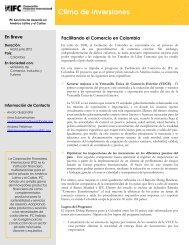
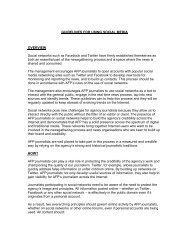
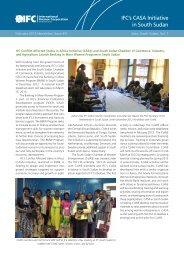

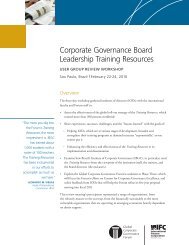




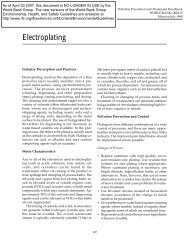

![Print a two-page fact sheet on this project [PDF] - IFC](https://img.yumpu.com/43449799/1/190x245/print-a-two-page-fact-sheet-on-this-project-pdf-ifc.jpg?quality=85)


